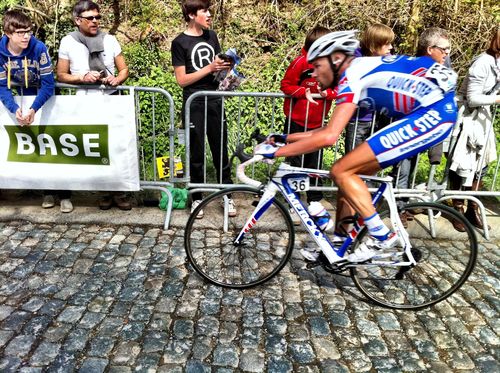
Climbing the Eikenberg, Tour of Flanders.
If you have ever fantasized about biking in Belgium, know this: Riding on cobbles is a painful, brutalizing business, like saddling up a jackhammer. I discovered this last weekend at the , a recreational ride for amateur cyclists that takes in the best of the a day before the pros race the 159-mile course. The romanticism of touring the twisting, scenic lanes that feature in some of spring’s most legendary races is inescapable, so when the opportunity arose to ride (courtesy of Giro, which was launching the new Aeon helmet at the race), I didn’t hesitate. I was oblivious to the flagellation for which I was signing up.
It must have been selective cluelessness because the , a trio of early-season events that includes Flanders, Paris-Roubaix, and Gent-Wevelgem, have a harrowing reputation. The courses are punctuated by stretches of rough-hewn cobbles that pop tires, snap carbon, and wreak havoc on racers chances. At Flanders, a series of 18 or so hellingen, short sharp climbs with ramps to 20 percent, complicate the race, not only because of the cobbles (which make traction tough) but also because these climbs are often only wide enough for three riders abreast. Positioning can make or break a race. Then there’s the weather, with temperatures that seldom top 40 Fahrenheit and more often than not a foggy, misty, rainy (even snowy) soup that turns the dirt between the cobbles to muddy paste and . It can be miserable, but that’s what gives these races their mystique. Paris Roubaix is, after all, known as The Hell of the North. Win a Cobbled Classic, and you are immortalized as one of the hardest men of cycling.
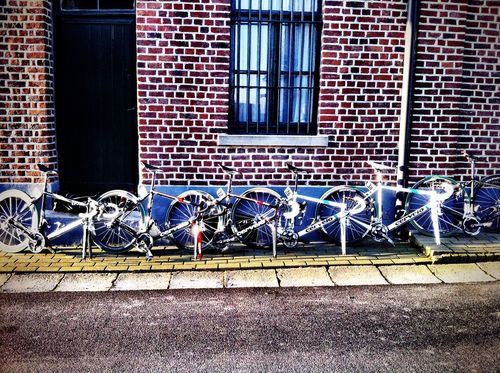
Lining up the fleet before the Flanders Cyclosportive.
I am no hard man, so on the morning of the 2011 Cyclosportive it suited me just fine when the clear sky dawned in striations of pearly pink. Glorious weather aside, the variable I hadn’t considered were the other riders—all 20,000 of them. Aside from the occasional lull thanks to traffic stops, I felt like I was riding in the Paris Métro at rush hour all day. On the first few hellingen, clearing the climbs had nothing to do with cadence but with how long you could track stand waiting for others to get get out of the way.
What really stunned me—like a slap in the face from a beautiful woman—was just how angry and cruel were the cobbles. On TV footage of these races, the pros show the strain of this stony �貹��é, but they still hustle along. When I hit the rough sections, my bike popped and clicked ominously, my back and neck groaned, my hands went numb, and on the first few sections I screeched to a quivering, slow-moving grind. “The cobbles at Flanders are nothing,” an old Frenchman told me as he zipped by on one early section. “They don’t even deserve to be called cobbles compared to the monstrosities at Roubaix.” Given that Flanders felt plenty savage so far, I hastily vowed to never ride Paris-Roubaix. As the miles clicked by, however, I discovered how to keep my momentum. And by day’s end I was reveling in the tricky riding—though I was nonetheless elated to reach the beer and brat tents at the finish.
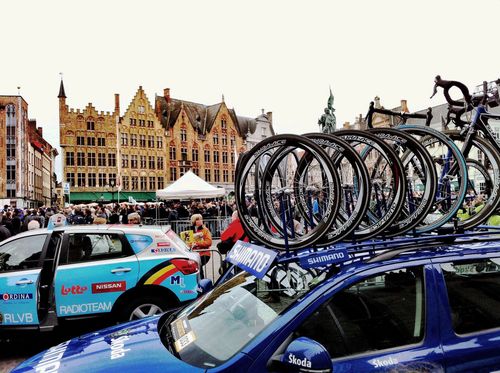
The start line in Bruges at the Tour of Flanders.
On Sunday the pros demonstrated how it’s done. Thousands of rowdy fans amassed in the turreted stone town of Bruges for the 10 a.m. start. Mist and cooler temperatures promised more classic Classic conditions, and a huge sign in the crowd—“Fabian Please Have Mercy!”—put word to local fears that Swiss world time trial champ, , would traipse all over hopes for a Belgian win, as . Following the start, we grabbed steaming waffles smothered in Nutella, as well as the obligatory breakfast beer, before driving south to catch up with the race on the twelfth climb of the day, the Eikenberg. I was both awed and depressed by the power and fluidity with which the peloton surged over the cobbles. Where I had been a Porsche rattling up a washboard road, these guys flew along like rally cars. After they’d sailed by, we picked up the action in a nearby bar, where teetering Belgians sucked down strong beer and shouted at the racers on TV.
It looked like it was going to be a repeat of the Cancellara show when, 25 miles from the finish, the big Swiss dropped the other favorites. It was in these last miles that I most appreciated my previous day’s tour because I knew each testing climb from experience and could empathize with how hard the lumpy parcours must have felt at redline.��The race lived up to its reputation as a great classic, too, with the field regrouping and breaking apart three times before local hero, , finally pipped Cancellara at the line for the win.
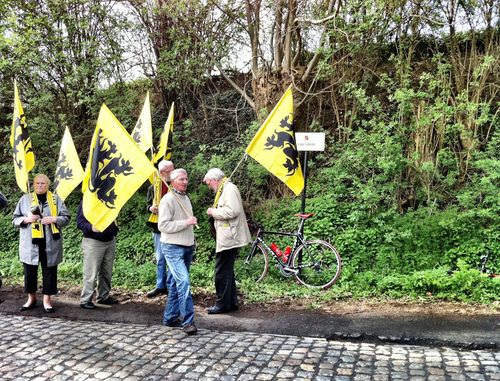
Lion of Flanders-toting Belgians await the arrival of the race.
The pub full of Belgians where we were watching erupted in boozy cheers and fresh rounds. And our hotel that night, where winner Nick Nuyens’ Saxo Bank team happened to be staying, was a mayhem of boisterous cyclists and TV crews and good cheer. The memory of the previous day’s rough riding was lost to the myopia of revelry. Caught up in it all, over one-too-many ales, I vowed that—thrashing be damned—I'd be back in 2012 for the Paris-Roubaix Cyclosportive. Hopefully the feeling in my hands will have returned by then.
The Gear
I have been testing an R3 for months, and the fact that it held up to the absolute drubbing of hours on blocky squares of granite solidified my high opinion of the bike. It felt absolutely balanced and sturdy in the cobbles yet light and snappy on the hellingen. It's refreshing to ride a “comfort” bike that feels like a race car, not a recliner. Look for a full review in the upcoming Buyer's Guide.
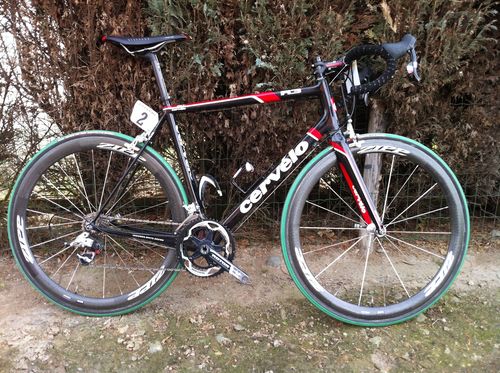
��I rode these medium-profile carbon rims with 27mm Vittoria tubulars, and I was amazed how supple the combination felt. They absolutely railed in the flats but were stable when the wind picked up. The performance shouldn't have surprised me: Cancellara won Flanders and Roubaix on these wheels in 2010, and Nuyens won on them this year.
��At Flanders, Team Garmin-Cervélo, Rabobank Cycling Team, and Team Radioshack debuted this new top-end road helmet, which��combines the ventilation and fully featured Roc Loc suspension system of the Ionos with the light weight of the ProLight.��After five hours wearing our medium sample (which weighed in at 8.4 ounces), the Aeon was so light and comfy that I barely even noticed it. It will be available in May at a cost of $250. Stay tuned for a full review as we log more ride time.
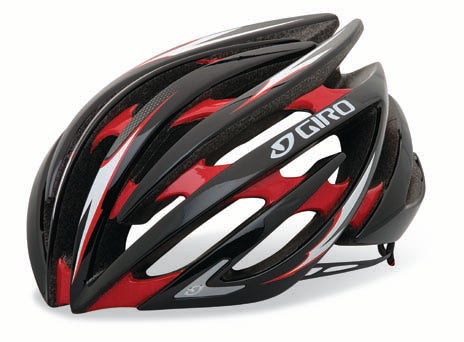
These bibs use the same X2 Progetto pad as I've been riding all spring in the company's Body Paint shorts. With variable thickness and no ill-placed seams, this chamois has been incredibly comfortable on the longest rides, and it proved itself once again on the rough roads at Flanders.
The Tours
With three springtime trips focused on the classics, this is the top choice for cyclists serious about experiencing the early season races. The Cobbles takes in the Tour of Flanders, Scheldeprijs, and Paris-Roubaix. On the Ardennes you'll see and ride Liége-Bastogne-Liége, La Flèche-Wallonne, and Amstel Gold. And La Primavera takes you to Milan-San Remo.
With a focus on the intimate travel experience, the Ardennes Spring Classics Week Bike Tour is an eight- or 12-day trip through the rolling hills and thick forests of the Ardennes region of Belgium and the Limburg region of Holland, including the Amstel Gold Cyclosportif and a trip up La Flèche-Wallonne's most famous climb, Mur de Huy.
Led by retired-US Postal ride Marty Jemison, who knows these roads well from his racing days, The Hell of the North tour gives an inside look at the Cobbled Classics on a ten-day tour around northwest Belgium that's anchored to the trio of races.
–Aaron Gulley